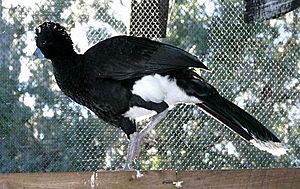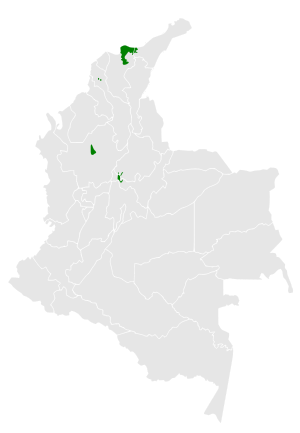Blue-billed curassow facts for kids
Quick facts for kids Blue-billed curassow |
|
|---|---|
 |
|
| Male | |
| Conservation status | |
| Scientific classification | |
| Genus: |
Crax
|
| Species: |
alberti
|
 |
|
| Distribution of the blue-billed curassow | |
The blue-billed curassow (Crax alberti) is a special kind of bird that belongs to a family called Cracidae. This family also includes birds like chachalacas, guans, and other curassows. This amazing bird is found only in Colombia.
Contents
Meet the Blue-Billed Curassow
The blue-billed curassow is a fairly large bird, growing to be about 82.5 to 92.5 centimeters (around 2.7 to 3 feet) long. It weighs between 3.2 and 3.6 kilograms (about 7 to 8 pounds).
What Makes Them Special?
This curassow is the only one with a bright blue cere (a waxy area above its beak) and a blue wattle. The wattle is a fleshy growth, and you'll only see it on the male birds.
Colors and Patterns
Most male blue-billed curassows are black. They have a white area under their tail and a white tip on their tail feathers. Female curassows are also mostly black, but their lower belly and the area under their tail are a reddish-brown color. They also have thin white stripes on their wings and tail. Sometimes, a rare female will have these stripes on her chest and belly too! Both male and female curassows have a crest of feathers on their heads. The male's crest is all black, while the female's is black and white.
Where Do Blue-Billed Curassows Live?
You can only find the blue-billed curassow in the northern parts of Colombia. They live in small, separate groups across different regions, from La Guajira and Magdalena Department in the north, down to Antioquia and Boyacá Department in the south.
Their Forest Home
These birds prefer to live in quiet, untouched forests. They usually live in tropical areas, from sea level up to about 600 meters (around 2,000 feet) high. In the past, they were sometimes found even higher, up to 1,200 meters (about 4,000 feet).
How Blue-Billed Curassows Behave
What Do They Eat?
Blue-billed curassows mostly look for food on the ground. Scientists haven't studied their diet a lot, but we know they eat fruits, worms, and insects. They also swallow sand and small stones. These help them digest their food, just like grit helps chickens!
Family Life
The breeding season for blue-billed curassows starts in December and lasts until at least April. They are thought to stay with one partner for life. They build a big nest using sticks and dead leaves. They hide their nests well in thick tangles of vines, usually in the lower or middle parts of the forest trees. A female curassow typically lays two eggs.
Their Calls
Male blue-billed curassows make a deep "boom" sound from the ground. It's a series of four or five deep notes, like "hmm...hmh...hmm...hmm...hmh," repeated over and over. Both male and female birds make an alarm call if they sense danger. It's a soft, high-pitched whistle that sounds like "peh-weeeéoh" or "pehoo."
Protecting the Blue-Billed Curassow
The IUCN (International Union for Conservation of Nature) has listed the blue-billed curassow as Critically Endangered. This means they are at a very high risk of disappearing forever.
Why Are They in Danger?
There are fewer than 1,500 adult blue-billed curassows left in the wild. Their numbers are still going down, and their forest homes are shrinking. The biggest threats to these birds are deforestation (when forests are cut down) and hunting.
Helping Them Survive
To help protect these special birds, the ProAves El Paujil Bird Reserve was created in 2003. This reserve in Santander Department helps protect one of the remaining groups of blue-billed curassows. Also, some of these birds have been successfully bred in zoos and special centers. This helps increase their numbers and gives hope for their future.
See also
 In Spanish: Paujil colombiano para niños
In Spanish: Paujil colombiano para niños


